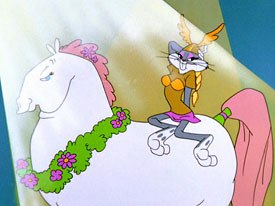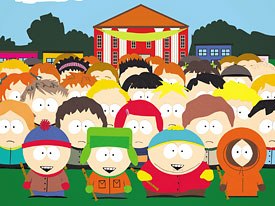This month, Dr. Toon dives into the deep end of the animation pool to see what “adult” really means throughout toon history.

Adult animation has been a problematic concept for decades, possibly due to cultural confusion over the term itself. In the typical sense, adult entertainment carries sexual connotations that run the gamut from the merely salacious to the outright pornographic. Using descriptors such as mature lends a more sophisticated air, but an underlying hint of carnality remains. This problem may possibly be the result of trying to design forms of entertainment that draw a clear line between assumed periods of psychosocial growth.
One obvious example is the current movie rating system, which I am sure no parent can adequately summarize, let alone apply to their progeny. When the term adult is applied to animation, a genre generally regarded to be the province of children, distinctions are even more difficult to make. American animation and American culture have never adequately reconciled the dilemma of what adult animation consists of, except that it is somehow more sophisticated than childrens fare and targets the population demographic aged 18-49.
It seems likely that the entire conundrum of what constitutes adult animation began in the early 1950s.
If that date seems curious to you, consider this we had adult animation all the time. We called it the theatrical cartoon. It is impossible to watch any part of the Warner Bros. manifest, for example, from 1940-1959 and not realize that children were not the primary intended audience. The increasing sophistication of humor, the references to celebrities and popular culture, and the comical, casual violence bespeaks volumes about what entertained movie audiences. It is inconceivable that said audiences were wholly or even mainly composed of children, or that Frank Tashlin, Chuck Jones or Bob Clampett were directors of kiddie fare. The latter two have stated that they made cartoons mostly to please themselves, based on what they found funny. If you require more proof, just listen to todays adults profess their love for the classic Looney Tunes.

Max and Dave Fleischer, in their most creative period, presented cartoons filled with sex, jazz and sophistication. It is difficult to make the case that even the beloved early Popeye cartoons had young audiences in mind. No one will ever accuse Tex Avery of making toons for tykes while at MGM, and it is certain that the artists and directors at UPA were aiming for a highbrow, art-savvy audience above the age of 13. When the cartoons became too expensive to recoup their costs and the great movie studios closed their animation departments, we essentially lost adult animation in America.
Cartoons made their march to the television set. For a brief moment, it seemed that the tradition of cartoons tailored to adult sensibilities might triumph. Beginning in 1958, the first efforts of ex-MGM directors Bill Hanna and Joe Barbera held promise using clever scripts that compensated for weak animation. Huckleberry Hound and his pals actually had a cult following, and it is no surprise that some of the writers had migrated over from Warner. Also coming to the small screen, in 1959, was Jay Ward and Bill Scotts satirical opus Rocky and His Friends.
In 1961, Bob Clampett tried mightily to appeal to adults with his outstanding Beany and Cecil series, and, for the most part, succeeded. Literate, funny and fresh, these three efforts, until recently, represented the last successful versions of adult animation. Men who were in their prime during the heyday of theatrical shorts made them, but they could not sway the overall march to mediocrity. Like a bright sun setting behind countless bowls of sugary cereals, television animation was about to sink into Saturday morning kidvid. For the next 20 years, the viewing public would hold the broad perception that cartoons were strictly for kids. Stringent efforts by broadcast standards and practices departments, as well as watchdog groups, only reinforced this view.
Some artists did fight the trend, but their intentions unraveled due to a heavy-handed reliance on sex and violence. Therefore, we have witnessed past missteps in which X-rated features, such as Charles Swensons Dirty Duck (1974) or Ralph Bakshis Fritz the Cat (1972) seemed to be breakthrough artifacts in defining adult animation. Unfortunately, the former film is virtually worthless and the latter film a promising, though ultimately failed experiment. Bakshi would return with several animated films that were far more mature in content. However, Coonskin (1975) and Heavy Traffic (1973) tended to have more shock than entertainment value due to the factors described above.
After spending considerable time as substandard fare and extended toy commercials, animation resurfaced in the late 1980s due to a confluence of fortunate events, The Disney films Who Framed Roger Rabbit (1988) and The Little Mermaid (1989), which were chartbusting hits. The first film adapted the detective noir film to images of classic cartoons, while the second wedded the Broadway musical to animation. Both genres are within the province of adult entertainment.
It was also at this time that a fantastic Japanese feature film, Akira (1989), opened American doors to a flood of sophisticated narratives that Asian (and American cult) audiences has been enjoying for some time. It is hardly surprising that The Simpsons (1990) followed shortly thereafter. This landmark series combined loony animation and the spirit of that decades sitcoms (with perhaps better writing) to create the most popular adult series to date, but it also signaled that animation was ready to launch into the adult domain.
By 1991, the foundations for mature animation were well in place. Both The Simpsons and The Ren & Stimpy Show were not only hits; they were fast becoming part of the currency of popular culture. Both generated considerable controversy at the time, and controversy is inseparable from public notoriety. Independents such as Marv Newland joined the fray; his infamous short Pink Komkommer was an important event in animation circles that year. Increasing amounts of breathtaking, mature anime flooded the country. Adult animation continued to progress in1991, taking root in a most unlikely milieu. Judy McGrath, the creative director at MTV, saw the signals and put Abby Terkuhle in charge of Music Televisions first animated series. Liquid Television was actually a collaborative effort between MTV and Britains BBC, and it was far less liquid than mercurial.
LTV featured a number of animated series within its 30-minute format, each lasting no more than a few minutes. Some artists, like Bill Plympton, got 60 seconds or less. Many of the animators were independents; a few of them were veterans of festivals and all of them were animating for adults only. Even the most (in)famous graduate of LTV, Mike Judges Beavis and Butt-Head, was not for the kiddies; it was aimed at young adults not long out of the phase in which the woeful protagonists were mired.
The stylish, ultra violent heroine Aeon Flux, a character heavily influenced by creator Peter Chungs love for anime, needed no dialogue in order to convey narrative to the audience. She soon appeared in a spinoff series as well. Bizarre segments such as Robin Steeles Stick Figure Theatre (which featured popular movie soundtracks voiced by kindergarten drawings) and The Specialists (a superhero/spy takeoff) were miniature delights for those disaffected by the mainstream. In all, LTV was a rapid-fire, non-linear attempt at bringing animation to the younger end of the 18-49 adult demographic; it actually succeeded across that spectrum.

Disney put the capstone on the seminal year of 1991 with its November release of Beauty and the Beast. This romance greatly appealed to adults and garnered American animations first Oscar nomination for Best Picture. The meta-message behind all the shouting, however, was as important as the cartoons themselves: Animation is now for grownups. The question now what direction would mature animation take? Sex, violence, obscenity and profanity had shown demonstrable limitations.
It was simply not possible to emulate the Japanese. Anime was not simply a matter of cels and storyboards. Much of what American audiences were seeing was the product of unique cultural factors that were not replicable in this country. While the Japanese, for example, had produced entire animated genres based on sex roles and mythologies developed over centuries, America had no such creative resources to tap. Some of the starkest anime had its roots in the psychological scars of Nagasaki and Hiroshima, wartime disasters such as Americans had never faced. The Japanese excelled at grafting their cultural themes into the animated science fiction, a genre that the U.S. had yet to develop to a serious degree.
By the time The Simpsons made its debut, some postulations were possible concerning what might constitute Americas version of mature animation. There would be some sexual suggestiveness and a reconsideration of the boundaries of violence, but some new rules began to emerge as well. Mature animation was far more self-reflexive and contained more referents to the greater culture and media than childrens shows. Shows that spawned a following by adults also tended to reference animated TV conventions of the past. At times, fondness ruled, but outright parody had its place as well. The third convention, one still in operation today, was the depiction of the outrageous and taboo with little regard for taste.
Often there was no (overt) sexual content. One can see many examples of all of the above in both early and recent incarnations of John Kricfaluis Ren & Stimpy series. Still, Kricfalusi was merely on the right track, one eventually derailed by contentious dealings with Nickelodeon, and perhaps by Kricfalusis own broadening vision of wedding Bob Clampetts sensibilities to modern narrative and convention. Kricfalusi was arguably best suited to take the next step in the development of mainstream adult animation, but that step fell to two playful auteurs instead.

There actually is a South Park, Colorado, but a mythical version of the same town and its inhabitants was about to become part of animation lore. Creators Matt Stone and Trey Parker had been a comedy writing team since the early 1990s, producing an irreverent film musical before creating the now infamous animated Christmas card that eventually became Comedy Centrals 1997 series, South Park. Stone and Parkers simple, disarming animation belied a strikingly subversive, very adult perspective. The four children that served as the shows protagonists were far from innocent waifs; their scatological speech and antisocial worldviews realized every nightmare about how society and media might warp a child, producing the monsters so feared by conservative adherents of family values.
These bouncy brats resided in a culture virtually designed to ruin them. Their teachers were dysfunctional headcases, their parents (and nearly every other adult) were clueless paragons of ineptitude and their closest adult moral compass was the sex-obsessed school chef. One child, the hapless Kenny, originally met a violent death in each episode. Adults loved the skewed characters, the unrelenting bashing of celebrities and the topical humor that kept South Park fresh through numerous seasons. Less experimental and somewhat more cohesive than LTV, South Park was a credible guide to those hoping to bring adult animation to primetime television and reap prodigious profits in the process. Stone and Parkers series was the subject of much scrutiny by hopeful producers and the networks ready to throw money at them by the fistful.
Before they were finished, they would seriously cripple every effort toward mature animation in America.
Next month: 1999- present: The uneven road taken by adult animation in America wends its bumpy way along.
Martin Dr. Toon Goodman is a longtime student and fan of animation. He lives in Anderson, Indiana.









